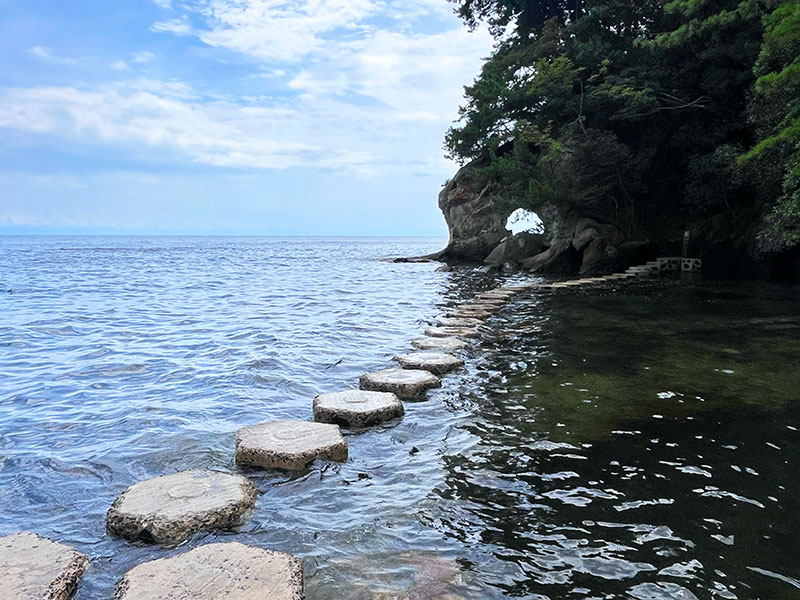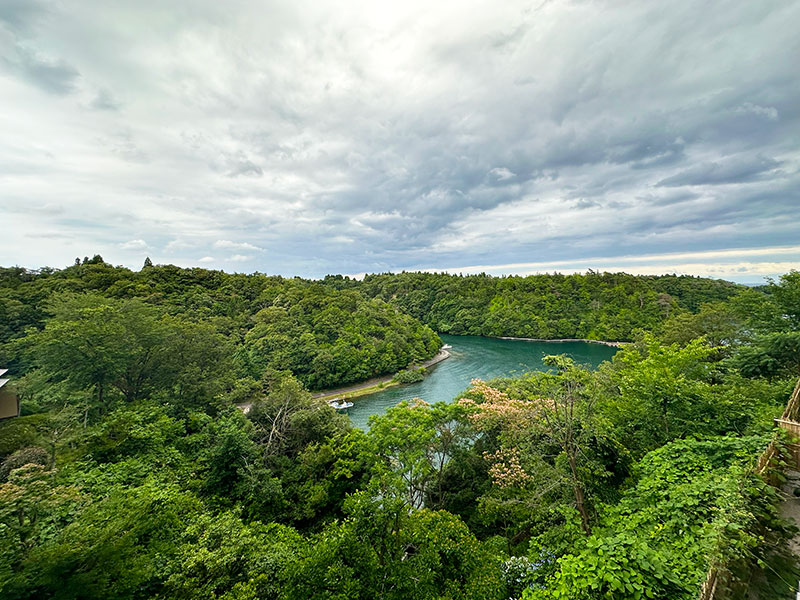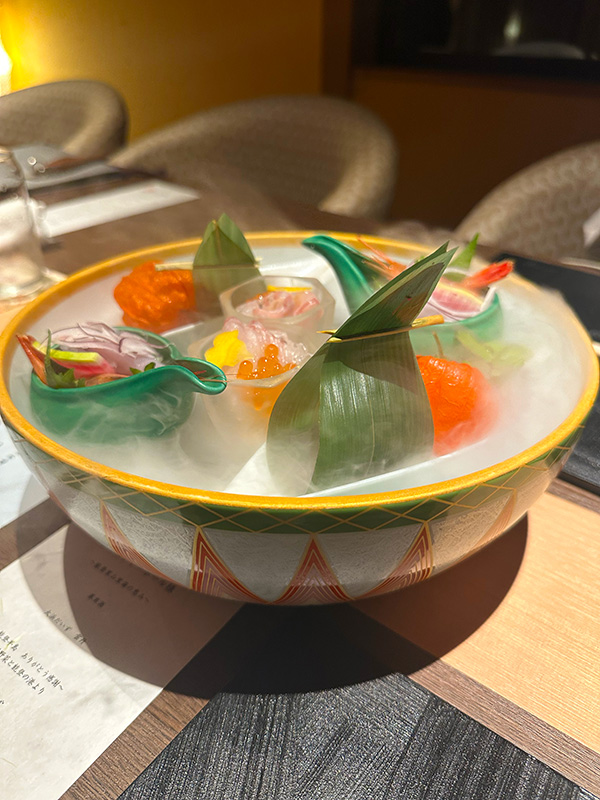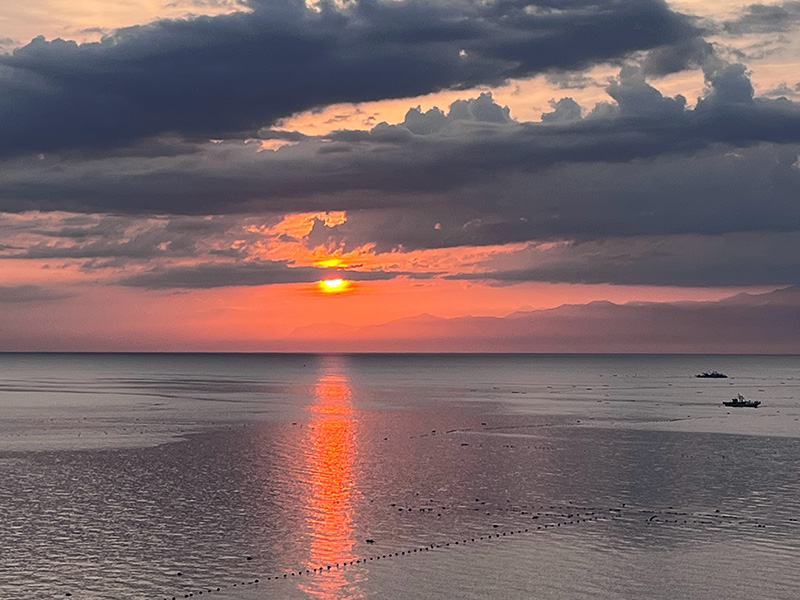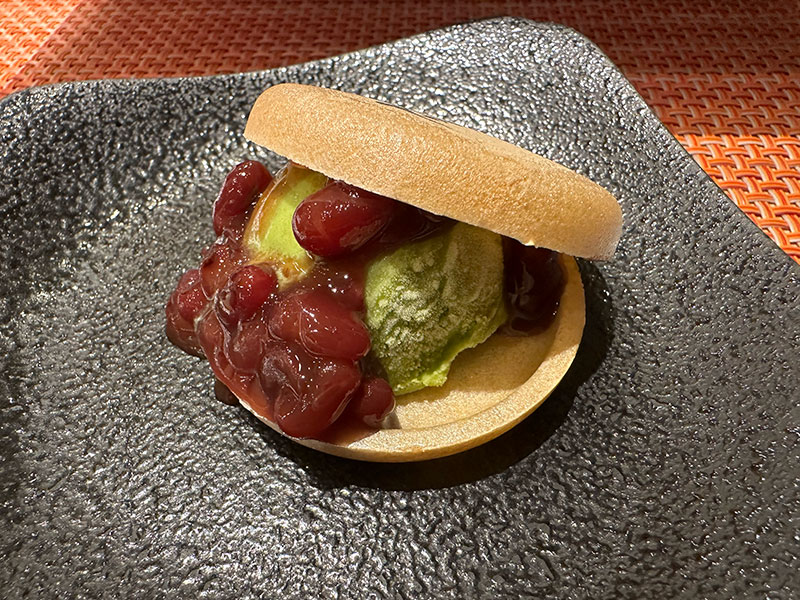A gentle walking tour to the rural Noto Peninsula in Ishikawa Prefecture with strong emphases on onsen thermal hot springs and Japanese gastronomy.
Gentle guided walking along paths through coastal and rural landscapes. Light walking combined with plentiful onsen hot spring baths and opulent cuisine. Accommodation in Japanese hotels.
Year-round.
A five-day, four-night tour starting in Kanazawa and finishing in Wakura Onsen. Accommodation is in Japanese hotels mostly with onsen thermal hot spring baths. Please read more on accommodation here. The small intimate nature of the tour makes the maximum group size 12 people. We have no minimum size. If we accept a booking we guarantee to run the tour.
On an Onsen Gastronomy tour, in the company of an expert Walk Japan tour leader, we are immersed in the Japanese way of bathing; stay each evening in pleasant accommodations including some top hotels in the area, almost always with their own onsen hot spring baths; and enjoy sumptuous meals that satisfy both the eye and the stomach. Our light guided strolling allows us to thoroughly enjoy the beautiful countryside we visit and also aids digestion of the gourmet meals, delicious titbits, sakes and other drinks included in the tour.
In flavour, quality of ingredients, range of dishes, health benefits, and sheer artistry of presentation, Japanese cuisine counts amongst the world’s best. Japan’s gastronomic offerings are an appetising and convivial element of all our tours, but in the Onsen Gastronomy series of tours we take this feature to a higher level for a celebration of the quintessential Japanese art of dining.
Onsen hot springs, enjoyed on many of our tours, are found throughout the length and breadth of Japan and are one of Japan’s great attractions; a perennial favourite amongst Japanese and overseas visitors alike. Enjoyed over the millennia for their relaxing, curative and restorative powers, onsen were used in Buddhism, which first arrived in Japan in 552, for purification rites. To this day, bathing in Japan remains a ritual, an art distinctly Japanese.
Noto is a gorgeously rural peninsula on Japan's northern coast that extends like a long crooked finger into the Sea of Japan. We had been thinking of providing tours here for a while but were spurred into action for a very poignant reason: A call for help.
Noto has long drawn visitors eager for its attractive countryside, local cuisine, onsen hot springs and fine crafts epitomised by Wajima lacquerware. However, on New Year’s Day 2024 life here suddenly came to all but a grinding halt when a 7.6 magnitude earthquake struck a few kilometres offshore, rattling the whole peninsula.
Although progress has been made in addressing the resultant wide disruption, the recovery will still take many years to complete leaving the locals in a state of semi-limbo for some time to come. The call to help came from a local activist group that led us to visit mid-summer 2024. The need for action was quickly apparent and, seeing the great potential amongst the disruption, we have worked with urgency to create this tour to the region.
Kaho, a Walk Japan colleague, who hails from the peninsula and experienced the earthquake first-hand while at home celebrating new year with her family, has been central to the tour’s development. Her vigour and forward-looking spirit reflects the wider community’s determination to rebuild their lives and once again welcome visitors sooner rather than later to Noto. Whilst the aftermath is necessarily an unavoidable element of the tour, the emphasis is very much on the positive; the spirited, resilient and welcoming locals, their society, food and craft, the wonderful accommodation and restaurants that have reopened but need guests more than ever, enjoyable walking, and, of course, the reviving and healing properties of onsen hot spring bathing.
The tour starts in the morning on Day 1 at Kanazawa Station, where the Walk Japan Tour Leader meets everyone joining the tour. Kanazawa is an elegant and interesting city with much to enjoy and we recommend spending a day or two here before the tour. Our time in Kanazawa is limited, but we do visit a couple of culinary related sites, including a wonderful restaurant for lunch, before heading for Noto. Day 2 sees us venture more deeply into the peninsula, where the damage caused by the earthquake becomes apparent as does the very friendly warmth of the locals. Throughout this tour we spend as much time with them as possible and this evening in Wajima, we meet some vibrant individuals who are determined to rebuild their community. On Day 3, our travels lead us to a more remote area of Noto, where we find one of Japan’s top hotels. Naturally, we stay here. Finally, on Day 4 we make our way to Wakura Onsen, a popular hot spring resort town where all the residents are working as one to bring their area back to vibrant life once again.
Important: Please note that in Japan it has traditionally been the custom not to allow anyone with tattoos to use public baths, including onsen. Although this custom is currently being relaxed, entrance is at the discretion of each establishment. Access at additional cost is usually allowed, however, to kazoku-buro private bathing facilities, which are found at many onsen, for anyone – including those with tattoos.
Due to the culinary focus on this tour, we are unable to cater to any dietary preferences, including allergies.

Day 1 Kanazawa - Hakui
The tour starts mid-morning at Kanazawa Station in Ishikawa Prefecture. Here, your Walk Japan Tour Leader awaits everyone’s arrival. Following a short tour briefing, we set off by private hire vehicle to circuit the centre of Kanazawa, an elegant city, and visit some culinary-related sites to help set the scene for our travels together. These include one of Kanazawa’s top sake breweries and restaurants. At the former, we are introduced to and sample Japan’s libation to the gods, and at the latter, enjoy a leisurely lunch.
Our meal is a delicious Japanese concoction of local dishes that satiates our appetite and senses, and sets a gastronomic high bar - something that we maintain throughout the rest of the tour. To aid our digestion, we enjoy a post-prandial leisurely guided stroll through an atmospheric port town on Kanazawa’s outskirts that was once an important staging post for the kitamae-bune trading ships during the Edo Period (1603-1868). These ships travelled from Osaka through the Seto Inland Sea as far as Japan’s most northerly isle, Hokkaido, and had a major gastronomic and cultural impact on the regions wherever they entered port, including Kanazawa and the Noto Peninsula. Our walk leads us via a shoyu soy sauce and miso paste brewery to an atmospheric local fish market, where we rejoin our vehicle for onward transfer to our accommodation for the evening in Hakui, the western gateway town to the Noto Peninsula.
Our hotel is known locally for its onsen hot spring baths but also its wide range of local dishes and drinks and wonderfully amenable staff. After a relaxing soak, we regroup to enjoy our dinner together and for your Tour Leader to provide a more in-depth tour briefing, introduction to Ishikawa Prefecture and especially the Noto Peninsula.
Accommodation: Modern Japanese inn with onsen hot spring baths.
Meals: Lunch & dinner provided.
Walking: 2.3km (1.4 miles).
Day 2 Hakui - Monzen-machi - Wajima
Breakfast in our accommodation is a feast of myriad dishes and sets us up well for our day traveling deeper into the Noto Peninsula. We re-board our private vehicle to transfer, firstly, to Keta Taisha, a wonderfully atmospheric Shinto shrine set aside a ‘forbidden forest’, and Myojo-ji, a temple with an impressive pagoda. Both are serene sights and give an indication of the rich culture found here since the 17th Century when the kitamae-bune trading ships were seen frequently plying their trade along the coast. After a short drive further north, we stroll around Fukuura, a small port town that flourished as a stopping point for the maritime trade between Osaka and Hokkaido. Today, it is a charming quiet backwater now known mostly for its unusual wooden lighthouse built in the 19th Century.
We continue further north along the peninsula’s coast and from hereon the effects of the New Year’s Day earthquake start to become apparent. Offshore here, the seafloor was uplifted by the vigorous seismic event by up to four metres, exposing the seabed and resulting in the beach being extended by up to 200 metres, leaving levees stranded high and dry.
We enjoy lunch at a nearby restaurant, which the owners have worked hard to reopen so they may once again welcome visitors and provide satisfying meals. A walk around the grounds of Soji-ji, the head temple of a Zen Buddhist sect, follows. A local joins to not only guide us through the grounds but also to describe the event that shook this ancient religious site and Monzen-machi, the surrounding town, to their core. The damage to the temple and its neighbours is significant, but the serenity of the temple, its monks, and local people shines through.
We transfer to Wajima, a town widely famed for its lacquerware. The extent and degree of damage is some of the greatest we come across on this tour. On the face of it, not something on many visitors’ wish lists. However, our focus is the resilient forward-looking attitude of the locals in rebuilding their town and lives. This is exemplified by a husband and wife team who exude extraordinary positive energy. Experts in Wajima lacquerware, they join us at a kappo fine dining restaurant to introduce us to this refined decorative art and also to enjoy dinner with us. The restaurant miraculously survived relatively unscathed, and our hosts, another engaging and energetic husband and wife team, serve us with a beautifully prepared banquet matched with regional sakes chosen from their wide selection.
Our accommodation for the evening is a modern business-style hotel. Currently the only option in town, it provides us with hot spring baths to luxuriate in.
Accommodation: Western-style hotel.
Meals: Breakfast, lunch & dinner provided.
Walking: 1.8km (1.1 miles).
Day 3 Wajima - Hosu
After a buffet-style breakfast in our accommodation, we travel east across the verdant hilly centre of the peninsula. En route, we stop at one of the best ice cream parlours in Japan. Although in a remote location far from anywhere, there is seemingly always a queue of people expectantly and patiently lined up outside awaiting their turn to be served. So delicious is the ice cream that many customers rejoin the queue to enjoy second helpings.
We now make our way to the coast and a seaside emporium dedicated to a complete opposite of ice cream, ika squid. Popular across Japan, the seas off the Noto Peninsula are particularly rich in these jet-propelled chameleons of the deep. Next, we visit an unusual facility that draws seawater from the same deep seas the squid swim in and processes it to create nutrient-rich water, pure drinking water, and crystallised and powdered salts. It proved to be a lifeline for the local community when the earthquake left waterlines ruptured for weeks afterwards by being the only source of this essential daily necessity.
Lunch is at an eclectic but delicious restaurant serving Japanese-Asian fusion dishes aside craft beers. Nearby is a park that celebrates the Jomon people, the ancient hunter-gatherer turned agriculturalist inhabitants of the Noto Peninsula. Here, we enjoy a quiet stroll and also find onsen hot springs baths to relax in.
A gentle walk beside the coast and, at times, literally over the sea brings us to our accommodation, a wonderfully idiosyncratic gorgeous hotel overlooking the sea. Besides beautiful surroundings and delicious food, its relaxing baths are found in caves 30 metres deep in the hard bedrock beneath the hotel. This same solid foundation helped protect the hotel from the seismic upheaval and, although not completely unscathed, allowed the premises to reopen relatively quickly and be an early symbol of how the locals are determined to rebuild their community and welcome visitors again.
Accommodation: Onsen hot spring resort.
Meals: Breakfast, lunch & dinner provided.
Walking: 2.6km (1.6 miles).
Day 4 Hosu - Nanao - Wakura Onsen
A late morning departure allows us to make the most of our delightful accommodation. Once again aboard our private-hire vehicle, we head south to Nanao, the eastern gateway to the Noto Peninsula. Here, we visit an informative and compact museum that introduces the society and culture of the area with a particular focus on its cuisine. With our appetites whetted, we enjoy lunch in a popular local restaurant before taking a stroll around central Nanao. En route, we visit a boutique shoyu soy sauce brewery and a world-famed candlestick maker. Both businesses, which were badly disrupted by the earthquake, have been revived by their owners with the great encouragement of the townspeople.
A short distance away is Wakura Onsen, long popular for its hot springs and our destination for the evening. The earthquake literally rocked the town to its foundations, forcing the closure of many establishments. So badly damaged are some that it will take years for them to re-open again. However, we find a warm welcome at one of the best, where the young hosts have worked tirelessly throughout 2024 to re-open their doors to guests. After a soothing soak in the onsen, we enjoy our last evening meal of the tour, a sumptuous banquet.
Accommodation: Onsen hot spring resort.
Meals: Breakfast, lunch & dinner provided.
Walking: 2.2km (1.4 miles).
Day 5 Wakura Onsen
The tour ends after breakfast and your Tour Leader will be on hand to advise on your onward journeys within Japan or to your departure airport from Wakura Onsen Station. Please do not hesitate to make your travel requirements known during the tour.
Accommodation: N/A
Meals: Breakfast provided.
Walking: N/A
The itinerary is subject to change
Transfer can be made by train from both Tokyo’s Narita and Haneda International Airports and Osaka’s Kansai International Airport. Flights are also available from Haneda Airport to Komatsu Airport in Ishikawa Prefecture.
BY PLANE TO KOMATSU AIRPORT
Domestic flights from Tokyo’s Haneda Airport to Komatsu Airport take approximately 60 minutes. From Komatsu Airport board the Airport Express Bus for Kanazawa Station. This journey takes approximately 40 minutes.
BY TRAIN TO KANAZAWA STATION
-----
FROM TOKYO’S HANEDA AIRPORT (HND)
Tokyo Monorail trains depart for and terminate at Hamamatsucho Station. Transfer here to the trains on either the JR Yamanote or JR Keihin-Tohoku Lines for Tokyo Station. To Kanazawa from Tokyo Station please see the section below.
-----
FROM TOKYO’S NARITA AIRPORT (NRT)
JR Narita Express (NEX) trains depart every 30 minutes for Tokyo Station. To Kanazawa from Tokyo Station please see the section below.
-----
FROM TOKYO STATION
From Tokyo Station, board the Hokuriku Shinkansen to Kanazawa. The journey takes approximately 2 hours 30 minutes.
-----
FROM OSAKA’S KANSAI INTERNATIONAL AIRPORT (KIX)
Take the Haruka Express train to Shin-Osaka from where the Limited Express Thunderbird train departs for Kanazawa. The journey takes between 3 to 4 hours.
The pre-tour pack includes detailed instructions, including a map, for travel to the accommodation at the start of the tour.



